Visiting Historic Georgetown
Williamson County Courthouse
Completed in 1911, this is the fifth courthouse to serve the citizens of Williamson County. It was designed by the Austin architectural firm of Charles H. Page & Bros. Although some of the building’s detailing was removed in the 1960s, it remains a fine Classical Revival structure featuring giant order Ionic columns and a copper dome with four-faced clock and a Justice statue. It serves as a focal point for Georgetown’s town square. Recorded Texas Historic Landmark – 1988
710 Main Street
Williamson County
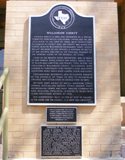 Created March 13, 1848, and organized by a special committee approved by Gov. George T. Wood and the 2nd Legislature of the State of Texas, with Georgetown designated as county seat. The county was named for Robert McAlpin Williamson (nicknamed “Three-Legged Willie”, because of his peg leg), a veteran of Battle of San Jacinto, and one of the original members of the Supreme Court of the Republic of Texas. Lying in the Brazos River watershed and in basin of San Gabriel River, county has widely varied soils of blackland, limestone, and prairie types. Before the creation of Williamson County, settlements were situated at Tumlinson’s Fort, Kenney’s Fort, and other locations. Early mills made lumber, flour, and cloth. Southwestern University, heir to charter granted by the Republic of Texas in 1840 to Rutersville College, was established in Georgetown in 1877. Settlers were mainly of Anglo-American, Czech, German, Mexican, and Swedish ethnic groups. Eight incorporated towns and many smaller communities have developed. Population increased to 38,000 (with 15,000 registered voters) by 1970. This courthouse — built in 1910 at cost of $96,000 — is the third for the county. C.H. Page was architect. (1970) Supplemental plaque: African Americans, the largest ethnic group among pioneer settlers, comprised ten percent of the county’s population in 1850 and more than nineteen percent by 1860.
Created March 13, 1848, and organized by a special committee approved by Gov. George T. Wood and the 2nd Legislature of the State of Texas, with Georgetown designated as county seat. The county was named for Robert McAlpin Williamson (nicknamed “Three-Legged Willie”, because of his peg leg), a veteran of Battle of San Jacinto, and one of the original members of the Supreme Court of the Republic of Texas. Lying in the Brazos River watershed and in basin of San Gabriel River, county has widely varied soils of blackland, limestone, and prairie types. Before the creation of Williamson County, settlements were situated at Tumlinson’s Fort, Kenney’s Fort, and other locations. Early mills made lumber, flour, and cloth. Southwestern University, heir to charter granted by the Republic of Texas in 1840 to Rutersville College, was established in Georgetown in 1877. Settlers were mainly of Anglo-American, Czech, German, Mexican, and Swedish ethnic groups. Eight incorporated towns and many smaller communities have developed. Population increased to 38,000 (with 15,000 registered voters) by 1970. This courthouse — built in 1910 at cost of $96,000 — is the third for the county. C.H. Page was architect. (1970) Supplemental plaque: African Americans, the largest ethnic group among pioneer settlers, comprised ten percent of the county’s population in 1850 and more than nineteen percent by 1860.
710 Main Street
George Washington Glasscock, Sr.
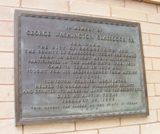 In memory of George Washington Glasscock, Sr. for whom the city of Georgetown and the county of Glasscock, Texas are named. Born in Kentucky April 11, 1810, participated in the Black Hawk War, 1832, came to Texas in 1834 and fought for its independence from Mexico 1835-36, surveyor, soldier, legislator, helped to organize Williamson County and donated 172 acres of land for the county site, died at Austin, Texas, February 28, 1868. This marker was placed by the State of Texas 1936.
In memory of George Washington Glasscock, Sr. for whom the city of Georgetown and the county of Glasscock, Texas are named. Born in Kentucky April 11, 1810, participated in the Black Hawk War, 1832, came to Texas in 1834 and fought for its independence from Mexico 1835-36, surveyor, soldier, legislator, helped to organize Williamson County and donated 172 acres of land for the county site, died at Austin, Texas, February 28, 1868. This marker was placed by the State of Texas 1936.
710 Main Street
Confederate Soldier and Sailor Monument
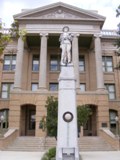 In 1917, the United Daughters of the Confederacy erected a memorial to confederate soldiers and sailors at the south entrance of the fifth and current Williamson County Courthouse.
In 1917, the United Daughters of the Confederacy erected a memorial to confederate soldiers and sailors at the south entrance of the fifth and current Williamson County Courthouse.
710 Main Street
Robert Jones Rivers
 In memory of Robert Jones Rivers, pioneer, patriot, lawyer and orator. Born in Virginia in 1806, died in Georgetown, December 4, 1854. His eloquence protected the helpless; his wit charmed all. Erected by the State of Texas 1938.
In memory of Robert Jones Rivers, pioneer, patriot, lawyer and orator. Born in Virginia in 1806, died in Georgetown, December 4, 1854. His eloquence protected the helpless; his wit charmed all. Erected by the State of Texas 1938.
710 Main Street
Judge Greenleaf Fisk
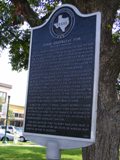 (May 19, 1807 – Jan. 26, 1888) Born in Albany, New York, Greenleaf Fisk was the son of a Presbyterian minister. He began preparation for the ministry himself but left his studies to migrate to the Texas frontier. In 1834 he settled in Bastrop. There he joined a company of volunteers and fought at the Battle of San Jacinto, April 21, 1836. Later he was elected to the Republic of Texas Senate. In the 1840s Fisk moved his family to a log house on the South San Gabriel River near present Leander. When Williamson County was organized in 1848, Fisk was the first “chief justice,” as the office of county judge was then called, a position he had held in Bastrop County. It is said that he often waled the 11 or 12 miles from his home to the courthouse in Georgetown. Fisk was also a surveyor, and many land records in Williamson County bear his name. In 1860 Fisk moved to Brown County, where he again served as county judge and held other county offices. He donated 60 acres for the town site of Brownwood and additional acreage for county use. His grave is in Brownwood’s Greenleaf Cemetery. Fisk was married first to Mary Manlove, who is buried near Leander. After her death, he married Mary Hawkins. He had 15 children. (1976)
(May 19, 1807 – Jan. 26, 1888) Born in Albany, New York, Greenleaf Fisk was the son of a Presbyterian minister. He began preparation for the ministry himself but left his studies to migrate to the Texas frontier. In 1834 he settled in Bastrop. There he joined a company of volunteers and fought at the Battle of San Jacinto, April 21, 1836. Later he was elected to the Republic of Texas Senate. In the 1840s Fisk moved his family to a log house on the South San Gabriel River near present Leander. When Williamson County was organized in 1848, Fisk was the first “chief justice,” as the office of county judge was then called, a position he had held in Bastrop County. It is said that he often waled the 11 or 12 miles from his home to the courthouse in Georgetown. Fisk was also a surveyor, and many land records in Williamson County bear his name. In 1860 Fisk moved to Brown County, where he again served as county judge and held other county offices. He donated 60 acres for the town site of Brownwood and additional acreage for county use. His grave is in Brownwood’s Greenleaf Cemetery. Fisk was married first to Mary Manlove, who is buried near Leander. After her death, he married Mary Hawkins. He had 15 children. (1976)
710 Main Street
Chief Justice John Edward Hickman
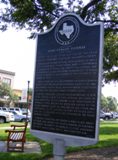 (1883-1962) A distinguished chief justice of the Texas Supreme Court, and a native of Williamson County. Descendant of 1849 settlers from Alabama, he was a son of Nathaniel Franklin and Mary J. Porterfield Hickman. He attended the Liberty Hill Normal and Commercial College, and (with interruptions to teach school) earned a law degree at the University of Texas in 1910. For 16 years he was an attorney in Dublin (Erath County) and Breckenridge (Stephens County). Oil was discovered in both areas, and with boom conditions his practice included some historic cases. Elected Associate Justice (1926), he became in 1928 Chief Justice, Court of Civil Appeals, Eastland. He was appointed to the Supreme Court Commission of Appeals in 1935; became an associate justice of the Texas Supreme Court in 1945; and on Jan. 7, 1948, was appointed Chief Justice — a post he filled until 1961. He is credited with 433 opinions of the Texas Supreme Court. A devout Christian, he taught a Bible class about 50 years, and served 1921-62 as a trustee of Southern Methodist University. He married (1) Ethel Markward (d. 1921) and (2) Lena Pettit, who survived him. (1971)
(1883-1962) A distinguished chief justice of the Texas Supreme Court, and a native of Williamson County. Descendant of 1849 settlers from Alabama, he was a son of Nathaniel Franklin and Mary J. Porterfield Hickman. He attended the Liberty Hill Normal and Commercial College, and (with interruptions to teach school) earned a law degree at the University of Texas in 1910. For 16 years he was an attorney in Dublin (Erath County) and Breckenridge (Stephens County). Oil was discovered in both areas, and with boom conditions his practice included some historic cases. Elected Associate Justice (1926), he became in 1928 Chief Justice, Court of Civil Appeals, Eastland. He was appointed to the Supreme Court Commission of Appeals in 1935; became an associate justice of the Texas Supreme Court in 1945; and on Jan. 7, 1948, was appointed Chief Justice — a post he filled until 1961. He is credited with 433 opinions of the Texas Supreme Court. A devout Christian, he taught a Bible class about 50 years, and served 1921-62 as a trustee of Southern Methodist University. He married (1) Ethel Markward (d. 1921) and (2) Lena Pettit, who survived him. (1971)
710 Main Street
Going Up the Texas Chisholm Trail
(1867) Cattle that passed farther north typically crossed the San Gabriel River near Georgetown. Today, families can relax along the same river in San Gabriel Park or explore Georgetown’s quaint historic town square, home to the distinctive Williamson County Courthouse. An annual event Up the Chisholm Trail Cattle Drive & Chuckwagon Cook-off recognizes Georgetown’s location on the historic Chisholm Trail, as well as Williamson County’s rich cattle-driving and ranching heritage.
710 Main Street
M.B. Lockett Building
Located on the site of an 1840s store, this structure was built after the Civil War. In the 1880s it housed the mercantile firm of Rucker & Montgomery. Ohio native Melville Beveridge Lockett opened his store here in 1889 and remodeled the building to its present Victorian design in 1896. Prominent architectural features include cast iron columns, an elaborate pressed metal parapet, and a corner turret with a domed oriel bay. Recorded Texas Historic Landmark – 1991
119 W 7th Street
H.C. Craig Building
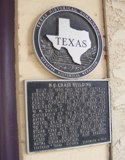 Built in 1903, this ornate Victorian structure originally housed the furniture store of Hugh Clifford Craig (1850-1938). Craig sold his business to local competitor W.H. Davis in 1906, but retained ownership of the building. In 1936, after the Davis Furniture Company moved, Craig sold the structure to S.W. Henderson, who ran a variety store here for many years. Elaborately designed, the building features iron columns and pressed metal ornamentation. Recorded Texas Historic Landmark – 1990
Built in 1903, this ornate Victorian structure originally housed the furniture store of Hugh Clifford Craig (1850-1938). Craig sold his business to local competitor W.H. Davis in 1906, but retained ownership of the building. In 1936, after the Davis Furniture Company moved, Craig sold the structure to S.W. Henderson, who ran a variety store here for many years. Elaborately designed, the building features iron columns and pressed metal ornamentation. Recorded Texas Historic Landmark – 1990
115 W 7th Street
C.A.D. Clamp
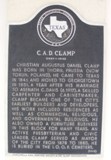 (1827-1915) Christian Augustus Daniel Clamp was born in Thorn, Prussia (now Torun, Poland). He came to Texas in 1846 and moved to Georgetown in 1851, a year after his marriage to Asenath C. Davis (d. 1917). A skilled carpenter and cabinetmaker, Clamp became one of the city’s earliest builders and developers. His work included residences as well as commercial, religious, and governmental buildings. He also owned a furniture business in this block for many years. An active Presbyterian and civic leader, Clamp served as mayor of the city from 1878 to 1880. He is buried in the I.O.O.F. Cemetery. (1990)
(1827-1915) Christian Augustus Daniel Clamp was born in Thorn, Prussia (now Torun, Poland). He came to Texas in 1846 and moved to Georgetown in 1851, a year after his marriage to Asenath C. Davis (d. 1917). A skilled carpenter and cabinetmaker, Clamp became one of the city’s earliest builders and developers. His work included residences as well as commercial, religious, and governmental buildings. He also owned a furniture business in this block for many years. An active Presbyterian and civic leader, Clamp served as mayor of the city from 1878 to 1880. He is buried in the I.O.O.F. Cemetery. (1990)
705 Main Street
Williamson County Sun
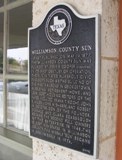 First published on May 19, 1877, the “Williamson County Sun” was founded by Jessie E. Cooper (1855-1944). In its first century of operation, the “Sun” initiated numerous civic projects, such as the building of the first railroad in Georgetown, Wesleyan Retirement Home, and low cost housing. Editors of the paper included Frank T. Roche, John R. Allen, John M. Sharpe, and Robert W. Cooper, son of the founder. Donald and Clara Scarbrough became the second full owners of the enterprise in 1948. The oldest newspaper in Williamson County, the weekly “Sun” became a semi-weekly in 1974. (1978)
First published on May 19, 1877, the “Williamson County Sun” was founded by Jessie E. Cooper (1855-1944). In its first century of operation, the “Sun” initiated numerous civic projects, such as the building of the first railroad in Georgetown, Wesleyan Retirement Home, and low cost housing. Editors of the paper included Frank T. Roche, John R. Allen, John M. Sharpe, and Robert W. Cooper, son of the founder. Donald and Clara Scarbrough became the second full owners of the enterprise in 1948. The oldest newspaper in Williamson County, the weekly “Sun” became a semi-weekly in 1974. (1978)
709 Main Street
Shafer Saddlery
On site of cabin used (1848) as first county courthouse. This frontier saddlery, erected 1870 of hand-cut limestone by John H. Shafer, had living quarters upstairs. Since 1872 occupants have been attorneys, a newspaper, and many other tenants. Recorded Texas Historic Landmark – 1971
711 Main Street
Old Dimmitt Building
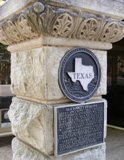 Associated with Texas pioneers, businessmen, statesmen, writers. Erected 1901 as a hotel by P.H. Dimmitt & Co. Later occupied by mercantile stores — meeting place for families and friends from Williamson County communities. Georgetown’s first movie house, then auto agency; later a drug store, dental office, bus depot. Remodeled 1960 by Georgetown Savings & Loan Association, preserving Spanish arches, columns, and turrets of native stone. Recorded Texas Historic Landmark – 1965
Associated with Texas pioneers, businessmen, statesmen, writers. Erected 1901 as a hotel by P.H. Dimmitt & Co. Later occupied by mercantile stores — meeting place for families and friends from Williamson County communities. Georgetown’s first movie house, then auto agency; later a drug store, dental office, bus depot. Remodeled 1960 by Georgetown Savings & Loan Association, preserving Spanish arches, columns, and turrets of native stone. Recorded Texas Historic Landmark – 1965
801 Main Street
Lesesne-Stone Building
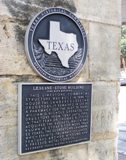 (The KGTN Building) This limestone commercial structure was built in 1884 to house the Sanders & Lesesne Drugstore. It remained in use as a pharmacy for the next 76 years. William D. Nichols operated the drugstore from 1887 until 1892. In that year, Dr. Thomas B. Stone acquired the business, which was known as Stone’s for more than 50 years. The Georgetown landmark, which exhibits Italianate influences, features arched windows and a pressed metal cornice. Recorded Texas Historic Landmark – 1983
(The KGTN Building) This limestone commercial structure was built in 1884 to house the Sanders & Lesesne Drugstore. It remained in use as a pharmacy for the next 76 years. William D. Nichols operated the drugstore from 1887 until 1892. In that year, Dr. Thomas B. Stone acquired the business, which was known as Stone’s for more than 50 years. The Georgetown landmark, which exhibits Italianate influences, features arched windows and a pressed metal cornice. Recorded Texas Historic Landmark – 1983
102 W 8th Street
Georgetown Fire House and Old City Hall
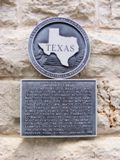 Designed by C.I. Belford and constructed in 1892 by C.W. Schell, this building originally housed the mayor’s office, city council chambers, city jail, fire department, and the Georgetown Water Co. Over the years, it also has served as a meeting place for the Second Baptist Church and as chamber of commerce offices. The building, which features some Italianate detailing, is one of few remaining examples of 19th-century city hall-fire stations in Texas. Recorded Texas Historic Landmark – 1984 ***Please note a misspelling of C. S. Belford – Charles Sanford Belford was a local builder with a National Register Historic District named after him.
Designed by C.I. Belford and constructed in 1892 by C.W. Schell, this building originally housed the mayor’s office, city council chambers, city jail, fire department, and the Georgetown Water Co. Over the years, it also has served as a meeting place for the Second Baptist Church and as chamber of commerce offices. The building, which features some Italianate detailing, is one of few remaining examples of 19th-century city hall-fire stations in Texas. Recorded Texas Historic Landmark – 1984 ***Please note a misspelling of C. S. Belford – Charles Sanford Belford was a local builder with a National Register Historic District named after him.
9th and Main
Emzy Taylor
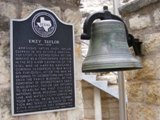 (1841-1895) Arkansas native Emzy Taylor clerked in his father’s Georgetown square mercantile store before serving as a Confederate Captain in the Red River valley during the Civil War. He married Margaret Henderson in 1864 while on furlough and after the war returned to Georgetown and took over the family business. At the forefront of Georgetown’s early development, Taylor led efforts to establish the first college, national bank, regional railroad line, and water utility service. He took special pride in his formation and service as chief of the city’s volunteer fire department. (1994)
(1841-1895) Arkansas native Emzy Taylor clerked in his father’s Georgetown square mercantile store before serving as a Confederate Captain in the Red River valley during the Civil War. He married Margaret Henderson in 1864 while on furlough and after the war returned to Georgetown and took over the family business. At the forefront of Georgetown’s early development, Taylor led efforts to establish the first college, national bank, regional railroad line, and water utility service. He took special pride in his formation and service as chief of the city’s volunteer fire department. (1994)
9th and Main
Founding of Georgetown
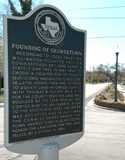 According to local tradition Williamson County’s first six commissioners met here under a stately oak tree in May 1848 to decide where the county seat should be located. Prominent local landowner George Washington Glasscock, Sr., later joined them and offered to donate an area of land bounded by the tree at one corner and the San Gabriel River to the north and west as a site for the county seat. The commissioners accepted his offer and in July 1848 named the town Georgetown in Glasscock’s honor. The landmark oak tree was felled by a storm in 1886. (1994)
According to local tradition Williamson County’s first six commissioners met here under a stately oak tree in May 1848 to decide where the county seat should be located. Prominent local landowner George Washington Glasscock, Sr., later joined them and offered to donate an area of land bounded by the tree at one corner and the San Gabriel River to the north and west as a site for the county seat. The commissioners accepted his offer and in July 1848 named the town Georgetown in Glasscock’s honor. The landmark oak tree was felled by a storm in 1886. (1994)
NW corner of Church and 9th Streets
Steele Store-Makemson Hotel Building
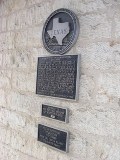 Built about 1870 by M.E. Steele on the site of an early log hotel, this is one of Georgetown’s oldest commercial structures. During Steele’s ownership it housed a mercantile and a bank. Emma Dickman Makemson later operated a hotel here from the early 1900s until 1924. Exhibiting influences of the Italianate style, the building features a truncated roof, corner entry, ornate frieze below the roofline, and finely crafted stonework. Recorded Texas Historic Landmark – 1988
Built about 1870 by M.E. Steele on the site of an early log hotel, this is one of Georgetown’s oldest commercial structures. During Steele’s ownership it housed a mercantile and a bank. Emma Dickman Makemson later operated a hotel here from the early 1900s until 1924. Exhibiting influences of the Italianate style, the building features a truncated roof, corner entry, ornate frieze below the roofline, and finely crafted stonework. Recorded Texas Historic Landmark – 1988
SW corner of Austin Avenue and 8th Street
Farmers State Bank Building
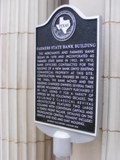 The Merchants and Farmers Bank began in 1898 and incorporated as Farmers State Bank in 1905. In 1910, bank officers contracted for the building of a new bank onto existing commercial property at this site. Construction was finished in 1912. In the 1960s, the bank moved and the building changed owners several times before Williamson County purchased it in 1967, using it for a variety of offices in the following decades. The building’s Classical Revival architecture features two large columns with Corinthian capitals and a temple front facade. Detailing on the pronounced central pediment includes dentils and egg and dart molding. Recorded Texas Historic Landmark – 2006
The Merchants and Farmers Bank began in 1898 and incorporated as Farmers State Bank in 1905. In 1910, bank officers contracted for the building of a new bank onto existing commercial property at this site. Construction was finished in 1912. In the 1960s, the bank moved and the building changed owners several times before Williamson County purchased it in 1967, using it for a variety of offices in the following decades. The building’s Classical Revival architecture features two large columns with Corinthian capitals and a temple front facade. Detailing on the pronounced central pediment includes dentils and egg and dart molding. Recorded Texas Historic Landmark – 2006
716 S Austin Avenue
The David Love Store
South Carolina native David M. Love (1821-1892) was an early settler of Wiliamson County. He was engaged in farming and ranching before moving to Georgetown in the 1860s. A prominent local business leader, he had this Victorian commercial structure built for his mercantile business in the mid-1880s. Features of the building include an ornate metal façade on the second floor, square pliasters, a decorative cornice, and a restored first-floor storefront. Recorded Texas Historic Landmark – 1988
706 Austin Avenue
Williamson County Jail
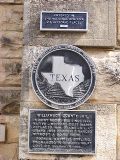 In continuous use since 1888. Native limestone cost $22,000. Replaced 1848 frame jail, at grand jury request. Financed without a bond issue. French Bastille styling, unchanged in remodeling, at cost of $40,000 in 1934. Recorded Texas Historic Landmark – 1965
In continuous use since 1888. Native limestone cost $22,000. Replaced 1848 frame jail, at grand jury request. Financed without a bond issue. French Bastille styling, unchanged in remodeling, at cost of $40,000 in 1934. Recorded Texas Historic Landmark – 1965
312 Main Street
Railroad Produce Depot
Built in 1904 by William Pearce to provide storage space for a wholesale grocery company, this building was part of a larger industrial complex. A number of buildings were constructed along nearby railroad lines, including an ice plant and bottling works, grist and planning mills, and a passenger and freight depot. Thick stone walls and spring water channeled through the basement of this structure helped to cool produce. This site is a reminder of the role industry and the railroad played in the economic development of Georgetown.
401 West 6th Street
[/tab] [tab title=”Red Poppy History” disabled=”no” anchor=”” url=”” target=”blank” class=””] In Flanders Fields In Flanders Fields the poppies blowBetween the crosses, row on row,
That mark our place; and in the sky
The larks, still bravely singing, fly
Scarce heard amid the guns below.
We are the Dead. Short days ago
We lived, felt dawn, saw sunset glow,
Loved and were loved, and now we lie
In Flanders Fields.
Take up our quarrel with the foe:
To you from failing hands we throw
The torch; be yours to hold it high.
If ye break faith with us who die
We shall not sleep, though poppies grow
In Flanders Fields. -John McCrae
Red Poppy Capital of Texas Georgetown is the “Red Poppy Capital of Texas,” certified by local residents and the Texas Legislature. Red poppies have been a part of Georgetown’s landscape for over seventy years. Red poppies grow naturally in street and highway right-of-ways, in vacant lots and park lands, and in native and cultivated areas of our citizen’s yards. We understand that Georgetown is one of the few locations in the United States where red poppies reseed themselves from year to year. Each April as the poppies bloom, Georgetown celebrates with the annual Red Poppy Festival, held on the beautiful historic downtown Square. Festival activities include live entertainment, arts and crafts, food, a children’s center, a car show, and a parade/cruise. Call 1-800-436-8696 for dates and additional information.
History of Red Poppies Seeds from poppies in Europe were sent to Georgetown right after World War I. Henry Purl Compton (known as “Okra”) who served in the American Expeditionary Forces sent them to his mother. She planted them at her home which is now 507 East 7th Street. From there, they were spread (by birds, bees, and people!) down the river and over much of Old Town.
Preservation They are the species papaver rhoeas. They are the emblem of the American Legion made famous by John McCrea’s poem “In Flanders Fields.” Red Poppies are part of the heritage so important to Georgetown’s present and future. In the 1980′s organizations like the Red Poppy Garden Club, City of Georgetown, and the Williamson County Sun began the preservation and spread of poppies all over town by giving away and selling millions of seeds of related American species. The latter grow and reseed themselves as well as those from Flanders Fields. Only “specialists” can tell the difference.
Planting September through November is the best time to plant the red poppy seeds for blooming in the Spring. Poppies grow best in direct sunlight. To plant the seeds, sprinkle the seeds in the desired area, then water. The plants will grow about two to three inches by December. Packets of seeds are available in the Visitor Center.
Blooming Central Texas wildflowers bloom from Spring until Fall; how early or how late depends on the weather. Most years our Red Poppies bloom in late March through April, as do the Bluebonnets and Indian Paintbrushes.[/tab] [tab title=”Historic Properties Driving Tour” disabled=”no” anchor=”” url=”” target=”blank” class=””]Georgetown’s quiet, tree-lined, inner neighborhoods and lovingly restored Square continue to lend the charm of yesteryear to this, Williamson County’s bustling seat of government. Prominently sited on high ground near the San Gabriel River, Georgetown still provides the same natural resources which encouraged early settlers to make their homes here. And Georgetown continues to offer the commercial, governmental, cultural and educational opportunities which stimulated later residents to share in the community’s superior quality of life.
Enjoy driving through neighborhoods in Old Town including the Belford and University Avenue/Elm Street National Register Historic Districts by following the attached home listings and map.
Historic Neighborhoods of Georgetown
Historic Neighborhoods of Georgetown Map
[/tab] [tab title=”Dan Moody History” disabled=”no” anchor=”” url=”” target=”blank” class=””]Dan Moody and his Williamson County legal team successfully prosecuted members of the Ku Klux Klan in the infamous Burleson flogging case. The trial took place in the early 1920s in the 26th District Courtroom of the Williamson County courthouse in Georgetown. This marked the first prosecution of the KKK that resulted in jail time. The ruling ultimately weakened the Klan, leading to the decline and downfall of the group on a national level. Moody’s victory did not go unnoticed, leading him to a successful bid for Attorney General of Texas in 1925. In an era of Ferguson dominated politics and corruption, Moody at the age of thirty-three was elected Governor of Texas—the youngest ever elected to that office. Moody’s administration focused on reform and fighting the culture of corruption previously established by the Ferguson administration. Moody restored confidence in the Texas government by recovering huge sums of public money in his crusade to expose corruption.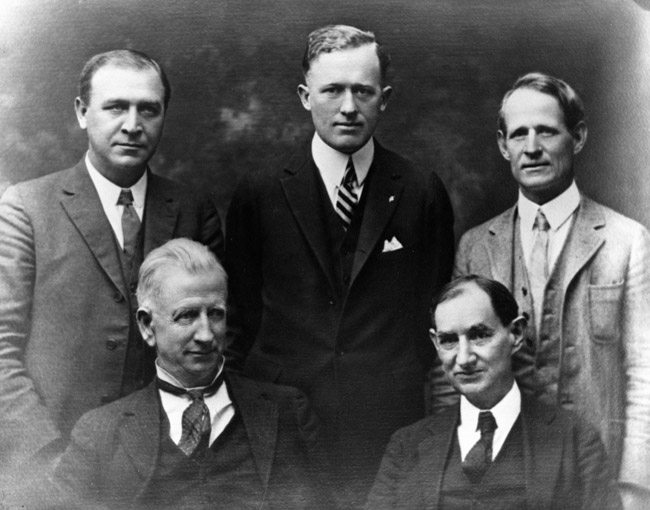
Dan Moody with group: Top row, left to right, Richard Critz, Dan Moody, Harry Graves; bottom row, J.F. Taulbee and W.H. Nunn. photo credit to Williamson County Museum
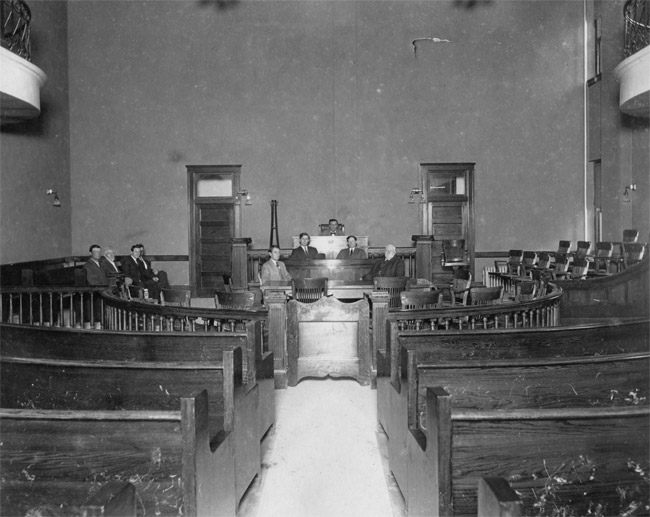
Williamson County Courthouse District Courtroom: Charles McMurray (county clerk) seated to the right; Judge Critz seated at center. Image ca. 1912. photo credit Williamson County Museum[/tab][/tabs]








